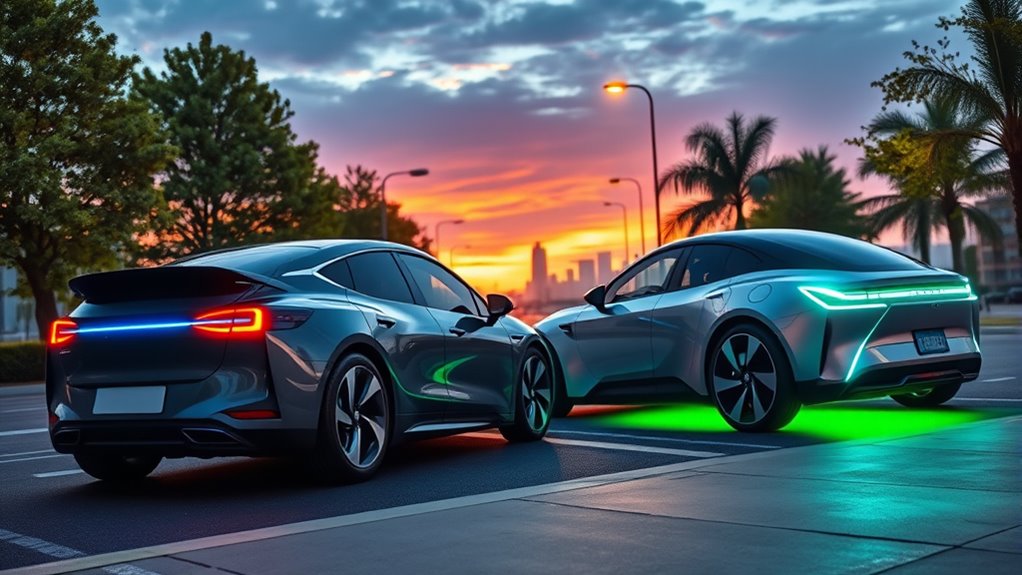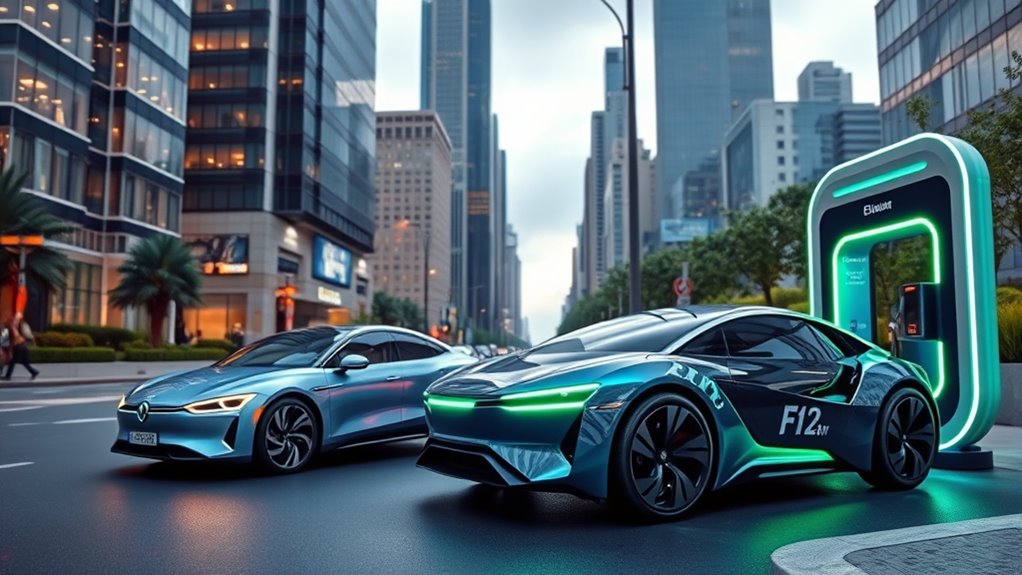Electric vehicles (EVs) and hydrogen fuel cell cars both offer promising paths toward sustainable transport. EVs benefit from battery advances that deliver longer ranges, faster charging, and falling costs. Hydrogen vehicles refuel quickly and produce zero emissions, but their infrastructure is limited. The future depends on expanding charging networks for EVs and building hydrogen refueling stations, along with cleaner production methods. To explore how these technologies compare and what’s next, keep exploring how innovation is shaping the transportation landscape.
Key Takeaways
- Electric vehicles benefit from widespread charging infrastructure and advancements in battery technology for longer ranges and faster charging.
- Hydrogen vehicles offer quick refueling and longer driving ranges but face limited refueling stations and infrastructure challenges.
- Battery recycling and renewable energy-powered electrolysis are key to making electric and hydrogen vehicles more environmentally sustainable.
- Infrastructure development is critical for both technologies to achieve mass adoption and compete with traditional fuels.
- Ongoing technological improvements in batteries and fuel cells will shape the future landscape of sustainable transportation.

As the world seeks cleaner energy solutions, electric and hydrogen power are emerging as leading contenders for transportation and industry. If you’re considering which technology will shape the future of sustainable vehicles, understanding their strengths and challenges is essential. Electric vehicles (EVs) rely heavily on advances in battery technology. Over recent years, improvements have made batteries more efficient, with higher energy densities and faster charging times. These enhancements mean you can now travel longer distances on a single charge and spend less time plugged in. However, the growth of EVs also depends on robust infrastructure development. Building widespread charging stations is critical so that you can conveniently recharge your vehicle without long waits or range anxiety. Governments and private companies are investing heavily in this infrastructure, aiming to make charging as accessible as fueling a traditional car. As you consider switching to electric, you’ll notice that the ease of charging and the expanding network are key factors in adoption. Additionally, ongoing research into battery recycling is crucial for minimizing environmental impact and ensuring sustainable growth of electric vehicle adoption.
Hydrogen vehicles, on the other hand, depend on different technological and infrastructural advances. They use fuel cells to convert hydrogen into electricity, offering quick refueling times similar to conventional gas stations. This makes hydrogen an attractive option if you’re looking for a solution with minimal downtime. Yet, the key hurdle remains in infrastructure development. Hydrogen refueling stations are still sparse, and establishing a widespread network requires significant investments and safety regulations. The production of hydrogen itself also influences its viability; currently, most hydrogen is produced from natural gas, which can undermine its environmental benefits unless cleaner methods like electrolysis powered by renewable energy are adopted. As you explore hydrogen options, you’ll find that ongoing improvements in fuel cell technology are making these vehicles more reliable and efficient. Still, without a dense, accessible network of refueling stations, widespread adoption remains challenging.
Frequently Asked Questions
What Are the Long-Term Environmental Impacts of Hydrogen Production?
The long-term environmental impacts of hydrogen production include potential hydrogen leakage, which can harm ecosystems if released into the atmosphere, and water resource impacts from water-intensive methods like electrolysis. If not managed properly, water scarcity could worsen, especially in arid regions. You should consider these factors when evaluating hydrogen’s sustainability, ensuring production methods prioritize minimal leakage and water use to reduce environmental harm over time.
How Do Vehicle Maintenance Costs Compare Between Electric and Hydrogen Cars?
You’ll find that electric vehicles generally have lower maintenance costs compared to hydrogen cars. With electric vehicles, you mainly need to monitor battery lifespan and occasionally replace parts like brakes and tires. Hydrogen cars, however, require regular checks on fueling station costs and hydrogen system components, which can be more expensive to maintain. Overall, electric vehicles tend to be simpler and cheaper to keep in good shape over time.
What Infrastructure Investments Are Needed for Widespread Hydrogen Adoption?
You’ll need significant infrastructure development to support widespread hydrogen adoption, focusing on hydrogen refueling stations across urban and rural areas. This involves investing in production facilities, storage, and distribution networks to guarantee availability and safety. Expanding these stations requires collaboration between government, industry, and communities, making it easier for drivers to access hydrogen refueling, ultimately encouraging more people to switch to hydrogen vehicles and accelerate the progression to sustainable transportation.
Are There Safety Concerns Unique to Hydrogen Fuel Cell Vehicles?
Hydrogen fuel cell vehicles have some safety concerns, but they’re manageable. You should be aware of hydrogen leak risks, which can be dangerous if not properly contained. The high-pressure storage tanks pose a challenge, but they’re built with advanced safety features that prevent leaks or explosions. While these risks sound alarming, strict regulations and technology improvements guarantee your safety, making hydrogen vehicles just as reliable as traditional cars.
How Do Government Incentives Differ for Electric and Hydrogen Vehicle Buyers?
You’ll find government incentives differ for electric and hydrogen vehicles due to subsidy disparities and regulatory frameworks. Electric vehicle buyers often benefit from more substantial subsidies, tax credits, and relaxed regulations, making EVs more affordable. In contrast, hydrogen incentives are less widespread, reflecting fewer subsidies and stricter regulations. These differences aim to encourage adoption, but the level of support varies depending on the technology’s maturity and policy priorities.
Conclusion
As you consider the future of sustainable vehicles, remember that electric cars currently make up over 10% of global vehicle sales, highlighting their rapid growth. While hydrogen offers promise with faster refueling times, the infrastructure is still developing. Ultimately, both technologies have potential, but your choice depends on factors like convenience and environmental impact. Embracing either path helps reduce emissions and drives us closer to a greener, cleaner planet. The future of mobility is within your reach.









